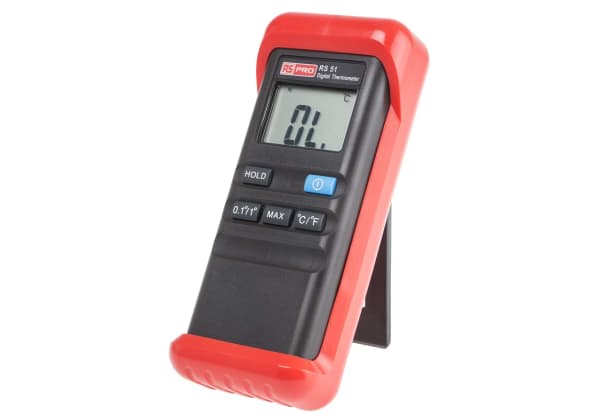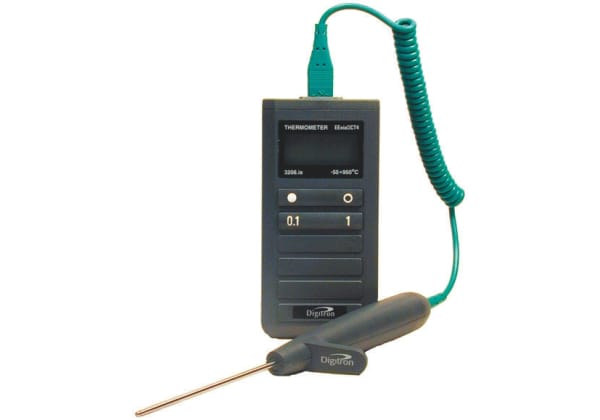- Published 23 Apr 2023
- Last Modified 29 Aug 2023
- 7 min
What are Temperature Probes?
A guide to different types of temperature probes. Explore the features and uses of RTDs, NTCs and thermocouples. Find an accurate, reliable temperature probe for your needs.

Temperature probes are devices that are used to measure the temperature of a solid, liquid or gas. They come in a variety of forms, with unique features and capabilities, making it important to choose the right type for your specific needs. This guide will take a deep dive into the benefits, uses and key features of different temperature probes.
Why are Temperature Probes Better than Thermometers?
Temperature probes offer improved accuracy, reliability and versatility over traditional thermometers.
The benefits of temperature probes include:
- Accuracy: Temperature probes often offer higher accuracy than traditional thermometers, as they measure the temperature directly
- Speed: They can typically provide a temperature reading much more quickly than traditional thermometers, allowing for real-time monitoring and control
- Repeatability: Often they offer greater repeatability, meaning that they provide consistent readings each time they are used. This can be especially important in industries where precise temperature control is crucial
- Durability: Many temperature probes are designed to withstand harsh environments, making them more durable and longer-lasting than traditional thermometers
- Versatility: They come in a variety of forms, making it possible to measure the temperature of liquids, solids, and gases
- Remote monitoring: Some temperature probes can be connected to data logging systems or other monitoring equipment, allowing for remote monitoring of temperature data
How Do Temperature Probes Work?
There are a number of different types of temperature probes, and the way a probe functions depends on its design and type. Generally, a temperature probe works by sensing something that is in contact with it. It senses a change in the characteristic of an object or environment, for example. Sensing elements are typically made of a material that will respond to a change in temperature, such as a semiconductor or ceramic. The probe houses either a contact sensor where physical contact is required or a non-contact sensor where infrared is used to measure from a distance. The probe itself is connected to a readout device that can convert the activity such as voltage into a temperature reading.
Temperature Probe Types
The most common temperature probe types are:
- RTDs (Resistance Temperature Detectors)
- NTC (Negative Temperature Coefficient)
- Thermocouples
The right type of probe will depend on the specific needs of the application.
RTD Temperature Probe
An RTD temperature probe (Resistance Temperature Detector) uses electrical resistance to measure temperature. RTDs are used in industrial applications, including process control and monitoring, and temperature calibration. RTDs are known for their high accuracy, repeatability, and stability, making them an ideal choice for applications where precise temperature control is crucial.
This type of probe uses the Wheatstone bridge circuit to measure the change in resistance caused by any change in temperature. This was first designed by Samuel Hunter Christie and later popularised by Charles Wheatstone. The diamond-shaped circuit compares an unknown resistance to a known resistance and uses two arms of the bridge to balance the resistance and produce a zero output. This design provides highly accurate measurements and is used in crucial industrial and scientific scenarios where precision is important.
Consider the following features to select an RTD:

- Material: The material of the RTD element will affect the accuracy, stability, and long-term performance of the probe. Platinum, nickel and copper are the most commonly used metals for RTDs
- Accuracy: The accuracy of an RTD can be influenced by several factors, including the material of the RTD element, the size and geometry of the element, and the stability of the Wheatstone bridge circuit
- Response time: The response time of an RTD temperature probe refers to the time it takes for the probe to reach its final reading after a step change in temperature
- Operating range: RTDs typically have a wider operating range than other types of temperature probes, making them suitable for a variety of applications
- Connector type: RTDs are available with a variety of connector types, including screw terminals, plug-in connectors, and others
- Environmental protection: RTDs are available with a variety of environmental protection options, including protection against moisture, vibration, and electromagnetic interference

NTC Temperature Probe
An NTC temperature probe (Negative Temperature Coefficient) uses a thermistor to measure temperature. The resistance of this component will decrease when temperature increases. The changes in resistance can be used to measure the temperature.
NTC temperature probes are commonly used in a variety of applications, including temperature control, temperature monitoring, and temperature compensation. NTC probes are known for their fast response time, high sensitivity and low cost, making them an attractive choice for many applications.
In addition to accuracy, operating range and connector type, consider the following when selecting an NTC temperature probe:
- Material: NTC thermistors are typically made of ceramics or polymers
- B value: The B value of an NTC temperature probe is a measure of its sensitivity to temperature changes

Thermocouples
A thermocouple is a combination of two wires made of different metals. When the junction between the metals experiences a temperature change, a small electrical voltage is generated. The size of the induced voltage can be used to determine the temperature.
Thermocouples have a wide temperature range. High accuracy and precision, along with fast response times, mean that thermocouples are used in a variety of circumstances, from industrial temperature probes to food temperature measurements.
Key factors to help you choose a thermocouple include:
- Type: The type of thermocouple you choose will depend on the specific requirements of your application. Some of the most common types include Type K, Type J, Type T, Type E, and Type N
- Temperature range: The wide measurement range is an advantage of thermocouples. Choose a range appropriate for your task
- Junction style: Thermocouples are available with a variety of junction styles, including exposed junctions, grounded junctions, and ungrounded junctions
- Sheath material: Thermocouples are available with a variety of sheath materials, including stainless steel, Inconel, and others
Calibration of Temperature Probes
Calibration is a critical step in ensuring the accuracy and reliability of temperature probes. The process involves comparing the readings of a temperature probe to a known standard and adjusting it as needed to ensure that it provides accurate and consistent measurements.
There are two main methods of calibrating temperature probes:
- Comparison Calibration: In this method, the temperature probe is compared to a known standard, such as a reference thermometer, at several different temperatures. If the readings from the probe differ from the reference thermometer, the probe can be adjusted until it provides readings that are within an acceptable tolerance range
- Bath Calibration: In this method, the temperature probe is immersed in a controlled environment, such as a temperature bath, where the temperature is maintained at a constant level. The temperature readings from the probe are compared to the temperature readings from the bath, and if necessary, the probe is adjusted to ensure that it provides readings that are within an acceptable tolerance range
Regardless of the method used, it is important to calibrate temperature probes on a regular basis to ensure that they continue to provide accurate and consistent measurements. How often you need to calibrate will depend on the specific requirements of the project and the stability of the probe.
In addition to regular calibration, temperature probes should be inspected and maintained on a regular basis to ensure that they are in good working condition and to identify and resolve any potential issues before they become serious.


